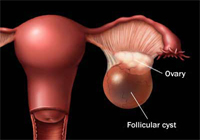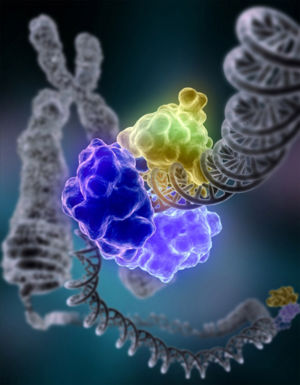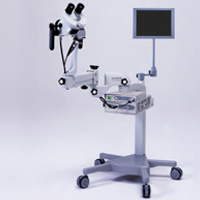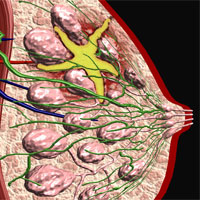In Russia, annually ovarian cancer detect more than 11 thousand. women. In most industrial countries, ovarian cancer has the highest mortality rates among all gynecological tumors. This is primarily due to the asymptomatic course of the disease in the early stages and late diagnosis.
Content
Manifestations of ovarian tumors
 About prematubological states of ovaries is known. These include benign egg tumors — Kistomy. Most ovarian crayfish develops against the background of the essential ovarian cyst. Ovarian tumors (benign and malignant) may occur at any age, but more often appear in 40 — 50 years. In frequency, they rank second among other tumors of female genital organs, with significant prevalence of benign forms (75 — 80%).
About prematubological states of ovaries is known. These include benign egg tumors — Kistomy. Most ovarian crayfish develops against the background of the essential ovarian cyst. Ovarian tumors (benign and malignant) may occur at any age, but more often appear in 40 — 50 years. In frequency, they rank second among other tumors of female genital organs, with significant prevalence of benign forms (75 — 80%).
The problem of recognition of malignant ovarian tumors is one of the most difficult and unresolved. Its relevance is due to the undoubted increase in morbidity and mortality from this pathology noted over the past decades in many countries of the world. Most of the sick-quality ovarian tumors come for treatment in the launched stages of the disease. Late diagnosis of malignant ovarian tumors is due to the limited clinical research methods for their recognition, as well as the lack of either the lack of subjective sensations in patients and, therefore, later, their appeal.
An unreliable symptom of ovarian tumors (benign and malignant) Painfulness, Sometimes very lungs denoted by patients only as «Singing» in the lower departments of the abdomen, mainly one-sided. Pains in most cases are associated with tumor pressure on adjacent organs. In some cases there is The feeling of gravity in the bottom of the abdomen, constant or periodic abdominal pain without a certain localization, often in the opposite region or hypochondrium. Pains can stop for more or less long periods of time. Maybe a disease manifest itself for the first time and sudden sharp pains as a result of twisting legs or breaking its capsules.
Rare symptoms of the disease
To the number of early, but rare symptoms of the disease belong Urination disorders or intestinal disorders As a result of the pressure of the ovary tumor on the bladder or the colon. The first symptom may be an increase in abdomen or appearance «Hardening» in it (by expression of patients).
With malignant tumors, as well as when the illicitality of benign tumors, the most noticeable symptoms, but not yet earnest, are the deterioration of the overall state and fast fatigue.
In most cases, even when the forms running, when the process in the form of small disseminates is distributed over all leaflets of peritoneum, liver, spleen, etc. organs, clinic has erased character. In some cases, it has a fuzzy character, expressed in discomfort from the gastro–intestinal tract in the form Losses of appetite, weakness, nausea, increase in abdominal.
Clinical manifestations with common forms are brighter than with early. In such cases, noted inThe intestinal contention, especially in the upper department and Saturation of the patient from small portions of food, which is due to the large volume of tumor, the appearance of metastases in the gland and on visceral peritoneum, creating difficulties in the dishevement of gases. As the tumor grows or at the increasing of ascites Increases belly, shortness of breath develops, a sense of cutting occurs. Tumor progression sometimes accompanies body temperature.
Menstrual cycle is broken, dysfunctional uterine bleeding occurs. The amount of urine released decreases. There are constipation.
Offic tumors in girls
 Ovarian tumors are found not only in adult women, but also in girls. More often they occur during puberty when significant hormonal shifts occur in the body.
Ovarian tumors are found not only in adult women, but also in girls. More often they occur during puberty when significant hormonal shifts occur in the body.
Just like adults, children distinguish benign and malignant neoplasms of ovarian.
The clinical picture of feminizing (ebinous) ovarian tumors in girls is manifested by the symptoms of premature puberty, the early sort of pubis and the groove zone and the increase in the mammary glands. The characteristic feature is also bleeding from sex tracts at the age of 5 — 7 years, which are quite abundant, long and not always cyclical.
Hormonoproducting ovarian tumors are rarely found in women in reproductive and in menopausal age. In the reproductive age draws attention to the termination of menstruation, while women of menopausal age appear «Cyclic monthly». All this helps in diagnosis. In recognition of the follicle, the ultrasound plays a big role. Highly efficient study of tumor markers. Nevertheless, the final conclusion can be obtained only after the operation, from morphologists — Microscopic.
Diagnosis of ovarian tumors
Palparatory diagnosis of ovarian tumors is based on the identification of various magnitudes and the shape of tumor formation in a small basin, painless, moderately and limitedly shifted, with a buggy or smooth surface having a dense or toughelastic consistency. Often in the morning when filling the bladder, the patient herself over the Lone proves a tumor.
The asymptomatic development of the tumor process in the ovaries in the early stages of the disease is forced clinicians to develop more advanced methods of their recognition and allocate the so-called group of patients with increased risk.
Signs of prior development of tumor cancer of ovarian
Judgments about the meaning of anamnestic data in patients with ovarian cancer are heterogeneous, but still, by summing them, you can find indications on the signs of preceding the development of tumors of hormonal disorders:
- Later the onset of menstruation;
- more frequent infertility;
- fewer pregnancies;
- Early or later onset of menopause at various nosological forms of tumors.
Of particular importance for malignant neoplasms, information about the preceding operation of a benign tumor of the ovarian. It is known that with one-sided removal of a benign tumor of the ovary, the occurrence of a tumor in another, left ovary, while already malignant. These are also important information about tumor diseases in the family.
 Stormy development of biological science in recent decades and especially intensive research in experimentally–Theoretical oncology made it possible to achieve significant success in the knowledge of genetic factors involved in the emergence of malignant neoplasms of ovarian in humans.
Stormy development of biological science in recent decades and especially intensive research in experimentally–Theoretical oncology made it possible to achieve significant success in the knowledge of genetic factors involved in the emergence of malignant neoplasms of ovarian in humans.
Currently, there is no doubt that the basis of malignant neoplasms of the ovaries lie damage to the genetic apparatus in various cells.
The hereditary factor is one of the important risk factors in the development of. Three syndrome of hereditary arrangement to the emergence of RAM are described: family cancer and syndrome, when in the family among the nearest relatives, the incidence of adenocarcinoma of such localizations, as a rectal cancer, breast cancer, endometrial cancer and ovarian cancer.
Existing factors and indirect evidence are sufficient to assume that this disease flows under conditions of exchange and hormonal changes in the body, t.E. In the presence of risk factors.
What is the risk factors? Concept «risk factors» introduced into clinical practice to search for «Practically healthy» people of change predisposing to cancer. At-risk groups — These are groups of the population who, due to the impact of various factors (age, professional, genetic, household, behavioral and exchange–endocrine) danger of occurrence and development of tumors higher than for other population groups, where there is no influence of these factors or small. In the presence of these factors in the body, there are changes characteristic of precancerous diseases and cancer. For cancer of various organs, the risk factors are unequal.
Risk factors, against which malignant ovarian tumors are developing
The most significant risk factors for malignant ovarian neoplasms
- Malignant tumors of the reproductive system in history
- Menarche under 12 years old (beginning of menstruation)
- Menopause in 50 years and older
- Chronic inflammation of the impudations
- Primary infertility
- Operations about benign formations in the ovaries
- Hereditary heredity of cancer of the bodies of the reproductive system
- Anguulatory uterine bleeding
- Sugar diabetes, obesity
- Lack of sex life in reproductive age
- Gynecological diseases (mioma, endometriosis, etc.)
- First pregnancy after 30 years
The allocation of risk factors is a mandatory study step towards early detection of reproductive system tumors. It should be emphasized that the danger of cancer of genitalia increases in the presence of the examined patients of two and three signs.
 In order to have risk factors, every woman when she feels healthy, should be on preventive examinations at least two times a year. Women with risk factors appeal to Akuster–Gynecologist, they are examined in depth, and this allows you to identify ovarian cancer at an early stage of the disease, in which the effectiveness of treatment is the highest.
In order to have risk factors, every woman when she feels healthy, should be on preventive examinations at least two times a year. Women with risk factors appeal to Akuster–Gynecologist, they are examined in depth, and this allows you to identify ovarian cancer at an early stage of the disease, in which the effectiveness of treatment is the highest.
When recognizing the ovarian tumors, the correct use of simple clinical methods is important. So, with a finger study of the area of appendages performed by the doctor, the tumor, sizes, its consistency and communication with the surrounding authorities are found in them. Rectovaginal research allows you to determine the lower pole of the tumor.
To clarify the diagnosis, the patient is examined and with the help of ultrasound scan of the pelvis in order to determine the volume of the ovary, the presence of pathological inclusions in it, blood flow velocity, the state of the endometrium, the volume of the uterine and T.D. With small neoplasms in a small pelvis, the highest informative has the highest informativeness (by introducing a sensor in the vagina) ultrasound.
The advantage of the ultrasound method in the diagnosis of ovarian tumors is its high informativeness, simplicity, speed, harmlessness, painlessness, the possibility of multiple conduct and objective documentation.
Of great importance in the diagnosis of malignant ovarian tumors is given by searching for tumor markers — Specific biological substances produced by a tumor, which can be determined by biochemical or immunological methods.
For in-depth diagnostics of malignant ovarian tumors, X-ray computer is used or magnetically–Resonant tomography. Restrictions on the use of the above methods is the high cost of equipment.
Ovarian cancer associated with smoking
Smoking women have three times more chances to get sick cancer than women never smoking. Research published in the journal will publish interesting facts: smoking cigarettes changes qualitatively and quantitatively physiological
Girona isolation, which leads to a delay in the body of carcinogenic substances and, ultimately, stimulates the development of malignant tumors.









